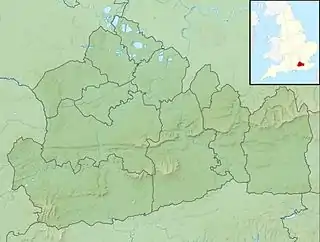Silvermere
Silvermere is an estate in Surrey, England named after its mere – a shallow lake of about ten acres which has a silvery appearance when seen from the surrounding slopes. It was created in the 19th century for the rich architect, William Atkinson, and subsequently became the home of the Seth Smith family, who had also become wealthy from property development. An ancient British burial mound was found on the land and the Silvermere Urn was found within. During World War II, the mere was used for experiments to develop and test the bouncing bomb. The estate is now a golf course and the final green is on an island in the mere.
| Silvermere | |
|---|---|
 Silvermere, looking east | |
 Silvermere | |
| Location | Surrey |
| Coordinates | 51°20′09″N 0°27′03″W |
| Type | Mere |
| Basin countries | United Kingdom |
| Surface area | 10 acres (4.0 ha) |


Atkinson family
It was part of the estate of the Oatlands Palace until 1830, when the architect William Atkinson bought 170 acres of land with the lake and erected a house there. He lived there for ten years until his death, when he was succeeded by his son Henry.[3]
The land had been mostly undeveloped heath, but Atkinson was interested in horticulture. He planted a large variety of rare plants and trees, including a comprehensive collection of pines which was one of the finest in England. The farmhouse of the estate was made of peat turf and the dairy had a similar turf roof which worked well to keep it cool.[4]
The Silvermere Urn
To construct Atkinson's house, earth was removed and this was found to be a burial mound. Three burial urns were found containing bones and charcoal. They were earthenware made of light clay and about eighteen inches tall. They seemed to be ancient British of a similar antiquity to the Iron Age settlement found on nearby St George's Hill, labelled among two other knolls south of the Thames which had borne celtic artefacts at various times in the 17th to 19th centuries as Caesar's Camp.[4][5]
Bouncing bombs
During the Second World War, the estate was owned by the Seth Smith family which had made a fortune developing Belgravia. Vickers staff from Weybridge were dispersed to this area and facilities for developing the bouncing bomb were based nearby in Foxwarren Park. In 1942, Barnes Wallis and his secretary, rowing champion Amy Gentry, rowed out onto the lake where Wallis fired differently-shaped models from a catapult and Gentry then rowed to retrieve them.[6][7] Later, in 1943, George Edwards, the manager of the Experimental department used the lake to demonstrate the mechanism for spinning and releasing the bombs. Lady Seth Smith was told that the project was secret and was quite agreeable about this activity, "Anything to do with beating the Germans, me boy, you can have, but don't make much noise while you are doing it."[8]
Golf course
The estate is now a golf club with associated leisure facilities. The course opened in 1976 and is of par 71 difficulty. The 17th and 18th holes include shots across the lake and the green for the 18th hole is a small island.[9][10]
References
Citations
- Surrey Archaeological Collections, Vol. 34–36, Surrey Archaeological Society, 1921, p. 2,
One urn in possession of A. Seth Smith, Esq., Silvermere, Cobham. Two not traceable. The Silvermere Barrow lies south of the road leading from Byfleet to Cobham. It is half a mile south of the "camp" on St. George's Hill...
- Eric Gardner (1949), Surrey Archaeological Collections, Surrey Archaeological Society, p. 137,
The Silvermere Urn ... It was then a "Landlord's fixture" in Silvermere House, Cobham. Now (1948) the house is empty and the urn has been presented by Mr. Seth Smith to his old school and it is now in the Charterhouse School Museum.
- Brayley 1841, p. 368.
- Brayley 1841, p. 369.
- "Wimbledon Museum". Wimbledon Museum. Retrieved 27 December 2013.
- Flower 2013, p. 25.
- Dildy 2012, p. 14.
- Gardner 2013, p. 48-49.
- About us, Silvermere Golf & Leisure
- About the course, Silvermere Golf & Leisure
Sources
- Brayley, Edward Wedlake (1841), A Topographical History of Surrey, vol. II, Fleet Street: Tilt and Bogue
- Dildy, Doug (2012), Dambusters – Operation Chastise 1943, ISBN 1780964625
- Flower, Stephen (2013), The Dam Busters: An Operational History of Barnes Wallis' Bombs, ISBN 1445618281
- Gardner, Robert (2013), From Bouncing Bombs to Concorde: The Authorised Biography of Aviation Pioneer George Edwards OM, The History Press, ISBN 9780752496030
